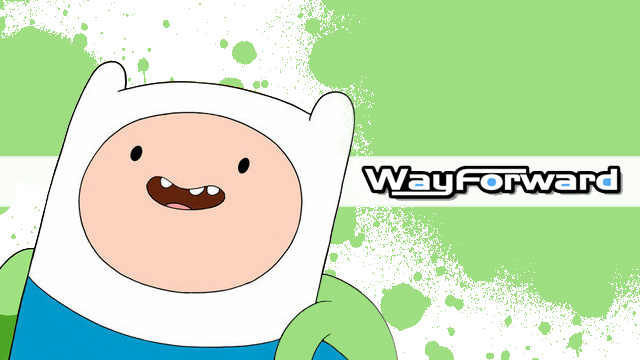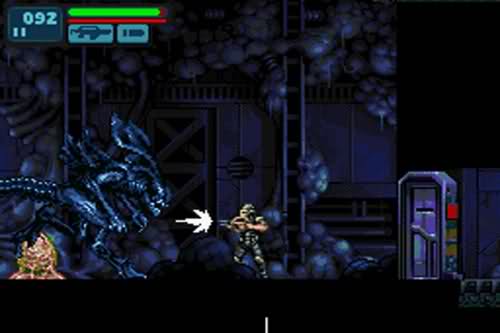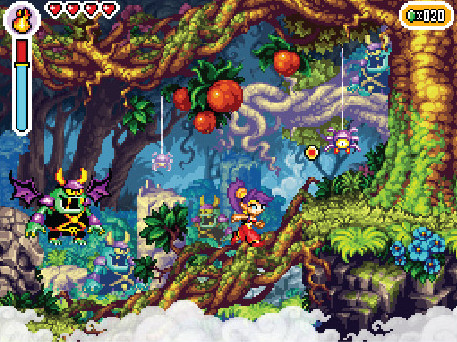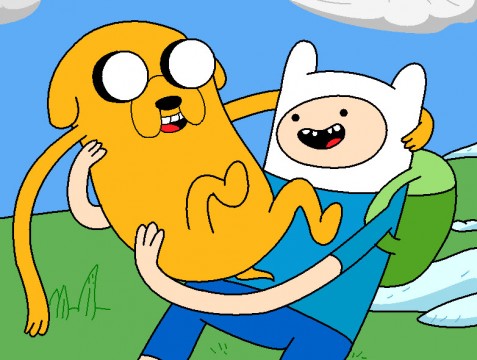
WayForward has certainly made a name for itself with its masterful 2D artwork and engaging play mechanics, but what you may not realize is just how germane these tenets are to its being. Amid the bustle of this year’s E3, we got the chance to sit down with Voldi Way, the tyrannical overlord (as he’s affectionately referred to on his business card) of the studio, to discuss their thoughts on art, game design, and some of the upcoming projects that fans have to look forward to (including the future of the Shantae series).
Nintendojo: First of all, thank you so much for joining us. Generally speaking, WayForward has always been there delivering exceptional content, doing good licensed games and taking advantage of digital distribution, which you guys have done exceptionally well.
Voldi Way: Yeah, we love it, we’re thrilled, like, any chance we get, you know, because, um– I’ve heard people are down on the eShop and stuff, and I don’t get it, unless they just– I don’t know. We love it. Honestly I wish we could do more, it’s just we keep getting busy doing work-for-hire projects, and so we have a whole list of things we want to do and the only thing holding us back actually is just time. You know how your personal projects take a back seat for the ones you’re getting paid, and our original stuff still only accounts for like 7% of our total revenue, so like 93% is what pays the bills. (laughs)
But yeah, we love it. If we had our way, we’d come out with a new eShop game every month.
ND: Even that 7% of your revenue, that’s still making money from the service?
Voldi: Oh yeah, and as far as the efforts go, they’re all very profitable, so it’s not like just a labor of love or anything. I mean, it is because we like doing it, but it’s also profitable, so we can totally justify doing it, it’s just, other projects come on and then– I don’t know. I wish I had a good answer for why we don’t do more. (laughs)
ND: Where do you think other companies might be stumbling on eShop?
Voldi: Uh, you know, maybe trying to do more– I was going to say do some more, like, iOS games on eShop because they don’t work on there in general. I mean some do, some work, but Nintendo has just such a specific audience. I mean, we’ve been developing for Nintendo since ’93 when we worked on Super Nintendo, and then Game Boy black-and-white, Game Boy Color, Game Boy Advance, DS, then Wii and 3DS, so I think we’re– it’s a hard question because it seems pretty obvious to us what Nintendo fans want, but then again, I guess if we tried to make a first-person shooter to compete with Call of Duty or something, we’d probably complain, “Ah, you can’t make money on Xbox Live!” It’s just what you’re used to.
ND: So if someone came up to you with $100 million to make the next big shooter, you’d pass? (laughs)
Voldi: Well in that case we probably wouldn’t. (laughs) But then we’d complain, “Ah, XBLA sucks, you can’t make any money.” Yeah, it’s just not in our DNA.
ND: How do you guys approach making licensed games? Do you familiarize yourself first with the license you’re working on and then develop the game around that?
Voldi: Yeah, actually it’s funny because we learned long ago that we can’t compete on prices with Eastern European developers and stuff like that, so we had to go for quality, and the positive side-effects of that are, we became sought after for the more premium brands and also the ones where the creators actually care, right? Those are the only brands you keep doing because you’re not an Eastern European developer who can do everything for half the price. But also for us, since we’re spending, you know, most of our waking and some of our sleeping hours working on this, we want to do something we’re proud of. Even if it’s a kids brand, not something that we would play, pretty much all of us have kids anyway, so we want something that they’ll be proud of and they’ll show off to their friends, stuff like that, so surprisingly, a lot of the brands we’re intimately familiar with, you know. We’ve done like twelve SpongeBob games or something, and one of our directors has been a writer on SpongeBob for five years, and on the side he’ll come in and help with the SpongeBob games. Barbie’s different, but a lot of us have daughters who’ve seen like every Barbie movie. So yeah, a lot of the brands we’re surprisingly familiar with, but on those occasions when we’re not, yeah we just immerse ourselves, you know, in DVDs and just watch the whole season of the series.
ND: “My kids like this game, I made this game, so I want my kids to play it.”
Voldi: Yeah, yeah, exactly. We’ll bounce ideas off of them. You’d be surprised how opinionated– actually, you probably wouldn’t be surprised, they’re extremely opinionated about that stuff. (laughs)
Now the big genres– I mean, we’ve done obviously a lot of kids games, and we’ve done a fair amount of superhero games, and we, um– I wish Adam [Tierney] was here because he’s our resident comic book expert. I mean, he can go list a hundred Batman B-villains that you didn’t even know existed off the top of his head, so for those there’s very little research. It’s usually he and the licenser at Marvel are just gonna do this mind meld, you know, so superheroes were always easy for us.
ND: One thing that has always interested us about WayForward’s projects is the strong focus on art in your games.
Voldi: Yeah, I wish Matt was here. I don’t know why Jordan set it up with me and not Matt because Matt is our creative director– Matt Bozon– and he went to CalArts, the California Institute of the Arts. It was started by Disney to train animators for Disney, and it’s generally regarded as one of the best animation schools in the country, if not actually the world, although some people say Japan has much better ones or Korea, but it’s just a different style. But as far as going to– if you want to go to an animation school, that is the place. They’re, like, all Disney guys, and Valencia, where we are, the kind of running joke is that everyone there has a neighbor working for Disney, but I think it’s true, like on every street there’s someone who works for Disney, so much so that some of the model homes, you know, if you’re buying a new home or something, actually have animation desks built into the furniture. Yeah, there’s so many animators there, and even to this day the vast majority of our artists came from CalArts and, I mean, frequently they’ve gone and worked in film and television first, so that’s why art is in our DNA, ‘cause I’ve been working with Matt since, well, ’93 actually, so it’s um, 19 years? Yeah, 19 years. And also, I think that it was a vicious cycle as far as, we do a lot of random stuff, you know, movie tie-ins. Like last year we did Thor, we did Happy Feet for the movie, we did Aliens, so we have to match art styles so often that it’s just we’ve gotten good at matching whatever they want.

ND: Do you guys prefer working in 2D or 3D?
Voldi: It’s a funny question because it depends on who you ask. I mean, believe it or not, we’ve shipped almost as many polygon-based games– at least in the recent decade– as we have pixel and hand-drawn ones, but we’re more well-known for hand-drawn because, you know, polygon games– so many other places do that, they just kind of blend in, but hand-drawn, not as many places do it, so I guess it depends on who you talk to. Pixel ones, I think it’s really tough to compete with us just because we’ve been doing it so long, so that one is a no-brainer for us. And, on a tight budget timeframe, some people think pixel stuff takes longer, but for us we can actually do it faster and cheaper than even traditional because the process has been refined. And hand-drawn, like in A Boy and His Blob, we were doing mostly on paper and pencil and we switched to tablets and using Toon Boom, which is what Disney uses for their films, you know, it’s an animation program, so a lot of our artists kind of like that, but then we have a whole 3D department that, you know, if you look at it, like Silent Hill, that’s more realistic– I mean, it’s still stylized, but more realistic, kind of gritty. So yeah, I guess there’s no preference there. If you talk to the engineers, um– well we’ve refined our tech for 2D, obviously, but 3D I think is more fun for programmers, so they’d probably go for 3D. And 3D also makes it easier to scale for different hardware. I don’t know what to answer; I feel like every answer I give is like, “Well it depends,” but that’s how it is. (laughs)
ND: Have you released games on any other digital distribution service?
Voldi: The only other one was– well iOS obviously, we did Shantae last year on Andriod. It’s only out in Korea and Japan now, weirdly, but we’re working on the US version too. And it was only because the publisher XSEED came to us and said, “Hey, can we ship Shantae in Japan and Korea? We’ll do the port,” and we’re like, “Sure.” And then, um, I think Might Switch Force is– we’re trying to get that on, it’s just– actually, I’m surprised we haven’t done that already. Oh, and then we did Mighty Flip Champs for PSP, but mostly Nintendo.
ND: Do you notice a big difference in terms of working with Sony versus working with Nintendo or any of the other services?
Voldi: Well Sony it’s hard to say because we’ve only put Champs, which was like a port. iOS I can say, uh– on the one hand it’s easy because they have no review. I mean basically in a few days your submission is up. If there are bugs, you know, they don’t patch them.
Nintendo is a lot longer process, but that said, our sales are, like, orders of magnitude better on eShop than iOS. Well iOS, you know, it’s so hit-or-miss, and it’s like you blend in to the 500,000 other apps, and if you get lucky and have an Angry Birds, then it’s great, but it’s just a total crap shoot, you know, whereas on Nintendo I think we have enough fans who will at least try that even on our weaker-selling games like Mighty Milky Way or something, you know, which was a total experiment– I don’t know if you haves have even seen that one– but we’re still really happy with sales. I like the eShop.
And Nintendo’s been really good to us. They feature us, I think, almost every week since it’s been out they have featured us in some random category or another, like “Games with Strong Female Leads” or um– one time we were in a “Games That Don’t Suck,” so I guess that’s good. (laughs)
ND: That’s always a compliment. (laughs)
Voldi: Yeah, yeah, whereas on the App Store you’re lucky– I mean we did get featured with Shantae for a few weeks, but it’s tough, you know. And they get like a hundred submissions a week, I think, that they have to pick from. Maybe more, I don’t know.
ND: Speaking of Shantae, is there anything coming down the pipeline that you can talk about?
Voldi: Um, I mean, I wish I could say something specific, but we are working on it. Like I would expect to see it on, you know, Wii U, it’s just, I don’t want to commit to a time because it always gets– even though we have been working on it, you know, like I said it gets pushed to the back burner, so originally we were hoping to have something for launch, but that’s clearly not going to happen. But yeah, Shantae is definitely in the works, and the last one, Risky’s Revenge, kind of left off on a down note, so we have to address that, right? So yeah, definitely more Shantae, for sure.

ND: That’s great to hear.
Voldi: Probably more Mighty stuff too, just because– the Mighty series, even though there’s no real continuity between it, it’s a good place for us to experiment with gameplay that no one else would let us do.
ND: And it seems really conducive to expansions.
Voldi: Oh yeah, Switch Force we added five new levels to. In fact, I’m pretty sure we’re the first people to offer just, like, a free update. I mean, people did say the first one was short, which we, you know, agree, it was a little short. Now hopefully it’s more substantial.
ND: Are you planning on releasing any more levels as paid downloadable content for Switch Force?
Voldi: You know, I don’t know. We’ve talked about it. I can honestly say it’s not exactly planned, but it’s not not-planned. I mean we’ve talked about it, we just haven’t done anything about it yet, and um– I don’t know if this is weird because we don’t know how other companies work. I think some people plan, like, years in advance or something. We just kind of– even Might Switch Force, that was like, “Hey, wouldn’t it be cool to do a game for the eShop?” “When’s it coming out?” “In like three months.” “Uh-oh, we better get started then.” Like, that’s the amount of planning that goes into it. “What’s the game going to be about?” “I don’t know, that’s Matt’s problem.”
ND: Is that the general process for you guys? Do you start with the idea before you move onto wrapping a world and characters around it?
Voldi: Well one thing I can say for sure is that, there are two schools of thought in game design: there’s bottom-up, and top-down. Most games, believe it or not, are done top-down like movies. They think of stories first. They’re like, “Well, we want a game where you’re an assassin, and you can get all these cool weapons and it’s going to be set in this post-apocalyptic world.” It’s all top-down, it’s all story. But what we do, we’ll start with just, like, a play mechanic, like a little box circling another box and when you press a button it launches out in a trajectory, or like Switch Force, which just– one of our programmers was testing 3D, you know, to adjust things back and forth, and Matt’s like, “Hey, what if there was a game where you jump but you have to decide which layer,” so we tend to very much design our games bottom-up, and any story– which is probably why you notice a sever lack of story, or if it seems kind of forced and added-on, it is. So yeah, we’re very much bottom-up.
Now for work-for-hire– it’s weird that we do that because for work-for-hire, they almost always approach top-down. Like it’s, “Oh, here’s a movie coming out, so you have to be like Thor, god of thunder,” and we read the script because frequently we start on it before the movie has anything to show, so we’ll kind of read through for villains and, you know, enemies like maybe some of the bigger bosses and stages. But then we quickly try to get it into the gameplay, so we’ll– every product we do we start with a gym level where it literally is just blocks and we’re testing jump heights, like we know we want to have soft collision where you can jump up but then land on it, we know that the character can’t be more than two blocks tall, so if some of our characters seem forced and a little more squat, it’s because gameplay-wise, it had to be no more than two blocks tall or it totally throws off our design.
ND: Was that the case with the Adventure Time video game?
Voldi: That one was actually very collaborative with Pendleton Ward because he had been tweeting about game designs forever, you know, like, “Oh I want it to be Zelda meets, you know, whatever,” so that one was very collaborative. And he actually has really good gameplay sensibilities too, you know, but he and Matt Bozon would just go on these sprees where they would just kind of work out what was happening. So yeah, that one’s been pretty fun. I wouldn’t say that one was as bottom-up. That one, he had come up with a story, like the garbage stealing thing, and he probably drew it on a napkin. I don’t know actually. He’s so funny because almost any email he sends there’s a picture attached, like some little sketch of, you know, Finn doing a thumbs up or something.

ND: Along those lines, were there any other work-for-hire projects that gave you free rein on the design?
Voldi: Um, you know, it’s been all over the place. Sometimes they’ll have a very detailed design, like this is what the design is and you can’t deviate. But then other times it is totally open, like Majesco is really cool to work with because they basically let us do our own stuff. I mean they’ll have input, they’ll have opinions and stuff, but basically they pretty much let us do whatever we want. I don’t know how they’d feel about me saying that, but– I should say they trust us to do their brand justice. Like BloodRayne was so different from the original. They came to us and said, “Do you want to do it?” and we were like, “Well, uh…I don’t know, can we do whatever we want?” And they were like, “Sure.” “Can we make it a side-scrolling brawler?” “Sure.” “Okay, great!”
ND: Now regarding something like BloodRayne, do you know what the possibility is of bringing that to Wii U?
Voldi: Um, well, tech-wise, totally, we’re all set, so I guess that’s up to them. You know what? You should bug them about it, and we’ll bug them, you know, because I don’t know why that one didn’t come up. I mean, they talked about putting it on Steam and stuff like that, but now that you mention it, they haven’t mentioned Wii U yet, and it should be on it.
ND: That’s about all the time we have today. Thank you very much for meeting with us!
Voldi: Yeah, thanks for asking me to!




 ShareThis
ShareThis






